Media and tray
This chapter provides information on how to load print media into your machine.
|
|
|
|
|
|
|
|
The use of inflammable media or foreign materials left in the printer may lead to overheating of the unit and, in rare cases may cause a fire. |
To change the size, you need to adjust the paper guide.
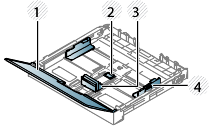
|
|
|
|
|
|
If you do not adjust the guide, it may cause paper registration, image skew, or jamming of the paper. |
-
Pull out the paper tray (see Tray overview).
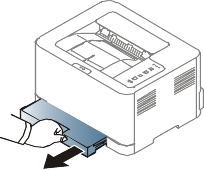
-
Open the paper cover.
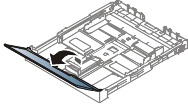
-
Press and unlatch the guide lock in the tray, pull the tray out manually. Then adjust the paper length guide and paper width guide.
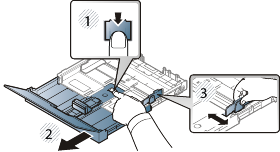
-
Flex or fan the edge of the paper stack to separate the pages before loading papers.

-
Place the paper with the side you want to print facing up.
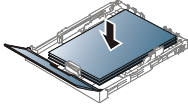
For paper smaller than Letter-sized, press and unlatch the guide lock in the tray, push the tray in manually. Then adjust the paper length guide and paper width guide.
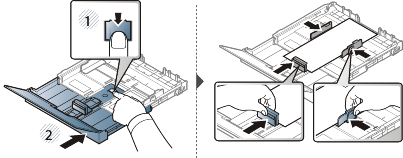
For paper longer than Legal-sized, press and unlatch the guide lock in the tray, pull the tray out manually. Then adjust the paper length guide and paper width guide.
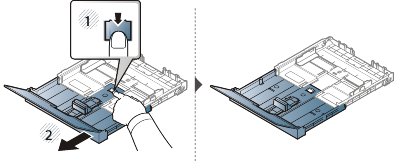
![[Note]](../../common/icon_note.png)
-
Do not push the paper width guide too far causing the media to warp.
-
Do not use a paper with a leading-edge curl, it may cause a paper jam or the paper can be wrinkled.
-
If you do not adjust the paper width guide, it may cause paper jams.

-
-
Squeeze the paper width guide and slide it to the edge of the paper stack without causing it to bend.
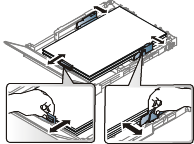
-
Close the paper cover.
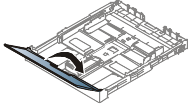
-
Insert the paper tray.
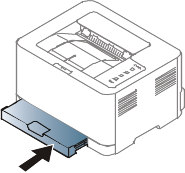
-
When you print a document, set the paper type and size for the tray (see Setting the paper size and type).
![[Note]](../../common/icon_note.png)
The settings made from the machine driver override the settings on the control panel.
-
To print in application, open an application and start the print menu.
-
Open (see Opening printing preferences).
-
Press the tab in , and select an appropriate paper type.
For example, if you want to use a label, set the paper type to .
-
Select (or ) in paper source, then press .
-
Start printing in application.
-
The table below shows the special media usable in each tray.
The media types are shown in the . To get the higest printing quality, select the proper media type from the window > tab > (see Opening printing preferences).
For example, if you want to print on labels, select for .
|
|
|
|
When using special media, we recommend you feed one sheet at a time (see Print media specifications ). |
To see for paper weights for each sheet, refer to Print media specifications .
|
Types |
Tray [a] |
|---|---|
|
|
● |
|
Thick |
● |
|
|
● |
|
|
● |
|
|
● |
|
|
● |
|
|
● |
|
|
● |
|
|
● |
|
|
● |
|
|
● |
|
|
● |
|
|
● |
|
[a] The paper types available manual feeding in tray. |
|
(●: Included, Blank: Not available)
To avoid damaging the machine, use only labels designed for use in laser printers.
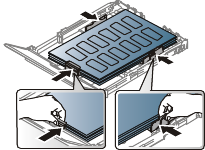
-
When selecting labels, consider the following factors:
-
Adhesives: Should be stable at your machine’s fusing temperature. Check your machine’s specifications to view the fusing temperature (about 170°C (338°F)).
-
Arrangement: Only use labels with no exposed backing between them. Labels can peel off sheets that have spaces between the labels, causing serious jams.
-
Curl: Must lie flat with no more than 5 mm of curl in any direction.
-
Condition: Do not use labels with wrinkles, bubbles, or other indications of separation.
-
-
Make sure that there is no exposed adhesive material between labels. Exposed areas can cause labels to peel off during printing, which can cause paper jams. Exposed adhesive can also cause damage to machine components.
-
Do not run a sheet of labels through the machine more than once. The adhesive backing is designed for only a single pass through the machine.
-
Do not use labels that are separating from the backing sheet or are wrinkled, bubbled, or otherwise damaged.
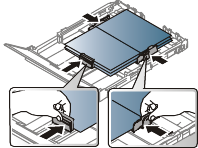
-
In the software application, set margins at least 6.4 mm (0.25 inches) away from the edges of the material.
When loading preprinted paper, the printed side should be facing up with an uncurled edge at the front. If you experience problems with paper feeding, turn the paper around. Note that print quality is not guaranteed.
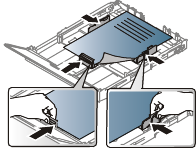
-
Must be printed with heat-resistant ink that will not melt, vaporize, or release hazardous emissions when subjected to the machine’s fusing temperature for 0.1 second (about 170°C (338°F)).
-
Preprinted paper ink must be non-flammable and should not adversely affect machine rollers.
-
Before you load preprinted paper, verify that the ink on the paper is dry. During the fusing process, wet ink can come off preprinted paper, reducing print quality.
Setting the paper size and type
After loading paper in the paper tray, set the paper size and type.
Open the (see Opening printing preferences) and set the paper size and type in the tab.
|
|
|
|
If you want to use special-sized paper such as billing paper, select in the tab in the (see Opening printing preferences). |